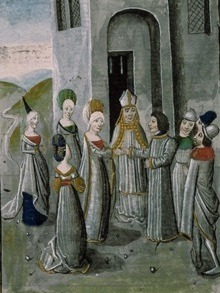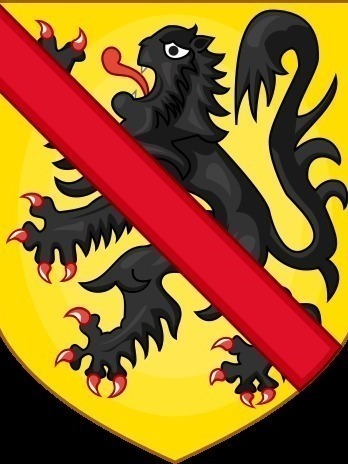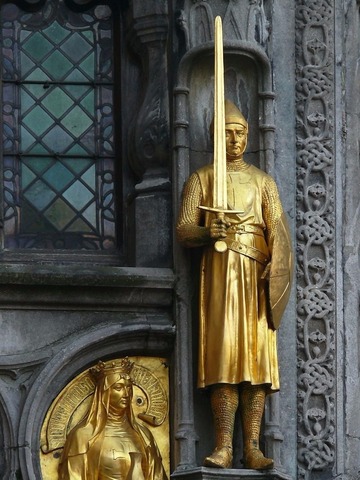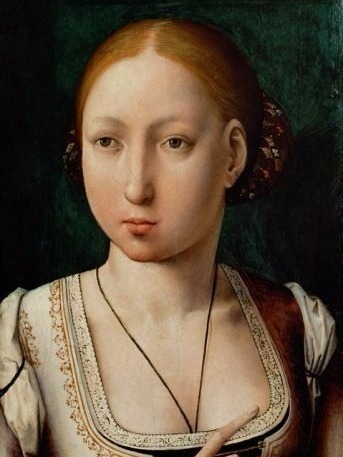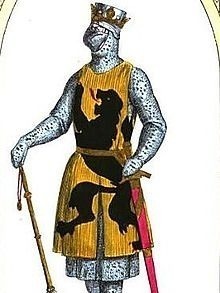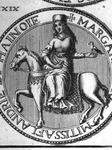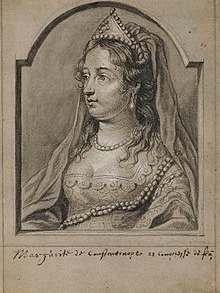Stamboom Snelder - Versteegh » Count Baudouin IX of Flanders Emperor of Constantinople (1171-1205)
Persoonlijke gegevens Count Baudouin IX of Flanders Emperor of Constantinople
Bronnen 1, 2- Hij is geboren juli 1171 in Valenciennes, Nord, Nord-Pas-de-Calais, France.
- Beroep: Comte de Flandre, Imperador de Constantinopla, Conde de Flanders e de Hainaut, Premier Empereur de Constantinople, EMPEROR OF CONSTANTINE EMPIRE, COUNT FLANDERS IX AND HAINAUT VI, LEADER OF 4TH CRUSADE, Emperor of Constantinople.
- Hij is overleden op 11 juni 1205 in Adrianople, Turkey, hij was toen 33 jaar oud.
- Een kind van Baldwin V of Hainaut en Margaret I of Flanders
Gezin van Count Baudouin IX of Flanders Emperor of Constantinople
Hij heeft/had een relatie met Marie of Champagne.
Kind(eren):
Notities over Count Baudouin IX of Flanders Emperor of Constantinople
https://en.wikipedia.org/wiki/Baldwin_I,_Latin_Emperor
Baldwin I (Flemish: Boudewijn I; French: Baudouin I; July 1172 – c. 1205), the first emperor of the Latin Empire of Constantinople, Baldwin IX Count of Flanders and Baldwin VI Count of Hainaut, was one of the most prominent leaders of the Fourth Crusade, which resulted in the sack of Constantinople and the conquest of large parts of the Byzantine Empire, and the foundation of the Latin Empire. He lost his final battle to Kaloyan, the emperor of Bulgaria, and spent his last days as his prisoner.
Baldwin was the son of Baldwin V, Count of Hainaut, and Margaret I, Countess of Flanders.[1] When the childless Flemish count Philip of Alsace left on the last of his personal crusades in 1177, he designated his brother-in-law Baldwin his heir. When Philip returned in 1179 after an unsuccessful siege of Harim during a joint campaign on behalf of the Principality of Antioch, he was designated as the chief adviser of prince Philip II Augustus by his sickly father Louis VII of France.[1] One year later, Philip of Alsace had his protégé married to his niece, Isabelle of Hainaut, offering the County of Artois and other Flemish territories as dowry, much to the dismay of Baldwin V.[2] In 1180, war broke out between Philip II and his mentor, resulting in the devastation of Picardy and Île-de-France; King Philip refused to give open battle and gained the upper hand, and Baldwin V, at first allied with his brother-in-law (Philip of Alsace), intervened on behalf of his son-in-law in 1184, in support of his daughter's interests.[3]
Count Philip's wife Elisabeth died in 1183, and Philip Augustus seized the province of Vermandois on behalf of Elisabeth's sister, Eleonore. Philip then remarried, to Matilda of Portugal. Philip gave Matilda a dower of a number of major Flemish towns, in an apparent slight to Baldwin V. Fearing that he would be surrounded by the royal domain of France and the County of Hainaut, Count Philip signed a peace treaty with Philip Augustus and Count Baldwin V on 10 March 1186, recognizing the cession of Vermandois to the king, although he was allowed to retain the title Count of Vermandois for the remainder of his life. Philip died without further issue of disease on the Third Crusade at the siege of Acre in 1191, he was succeeded in Flanders by Baldwin V of Hainaut, although the two had been on seemingly uncordial terms since the 1186 treaty.[3] Baldwin V thereupon ruled as Baldwin VIII of Flanders by right of marriage.[3] When Countess Margaret I died in 1194, Flanders descended to her eldest son Baldwin, who ruled as Baldwin IX, Count of Flanders.[3]
In 1186, the younger Baldwin had married Marie of Champagne, daughter of Count Henry I of Champagne and Countess Marie of France.[4] The chronicler Gislebertdescribes Baldwin as being infatuated with his young bride, who nevertheless preferred prayer to the marital bed.
Immediately after this arrangement, the count of Hainaut's son Baldwin, thirteen years old,[5] received as wife Marie, the count of Champagne's sister, twelve years old, at Château-Thierry. This Marie began sufficiently young to devote herself to divine obedience in prayers, vigils, fasts and alms. Her husband Baldwin, a young knight, by chaste living, scorning all other women, began to love her alone with a fervent love, which is rarely found in any man, so that he devoted himself to his sole wife only and was content with her alone. The solemn rejoicing of the wedding was celebrated at Valenciennes with an abundance of knights and ladies and men of whatever status.[6]
Through Marie, Baldwin had additional connections and obligations to the defenders of the Holy Land: her brother Henry II of Champagne had been King of Jerusalem in the 1190s (leaving a widow and two daughters who needed help to keep and regain their territories in Palestine). Marie's uncles Richard I of England and Philip II of France had just been on the Third Crusade.
Baldwin's own family had also been involved in the defence of Jerusalem: his uncle Philip had died on Crusade. Baldwin's maternal grandmother was great-aunt of Queen Isabella I of Jerusalem and the Counts of Flanders had tried to help Jerusalem relatives in their struggle. Baldwin wanted to continue the tradition. Margaret died in 1194, and the younger Baldwin became Count of Flanders. His father died the next year, and he succeeded to Hainaut.
Baldwin took possession of a much-reduced Flanders, lessened by the large chunk, including Artois, given by Philip of Alsace as dowry to Baldwin's sister Isabelle of Hainaut, and another significant piece to his own wife. Isabelle had died in 1190, but King Philip still retained her dowry, on behalf of Isabelle's son, the future Louis VIII of France. The eight years of Baldwin's rule in Flanders were dominated by his attempts to recover some of this land.[7] After Philip II of France took Baldwin's brother, Philippe of Namur, prisoner, Baldwin was forced to agree to a truce to ensure his safety. The Treaty of Péronne was signed in January 1200 on the condition that Baldwin receive the territories he had won during the war.[8] Baldwin was made the vassal of Philip II, and the king returned portions of Artois to Baldwin.[9][10]
In this fight against the French king, Baldwin allied with others who had quarrels with Philip, including kings Richard I and John of England, and the German King Otto IV. A month after the treaty, on Ash Wednesday (23 February) 1200 in the town of Bruges, Baldwin took the cross, meaning he committed to embark on a crusade.[11] He spent the next two years preparing, finally leaving on 14 April 1202.
As part of his effort to leave his domains in good order, Baldwin issued two notable charters for Hainaut. One detailed an extensive criminal code, and appears to be based on a now-lost charter of his father. The other laid down specific rules for inheritance. These are an important part of the legal tradition in Belgium.[12]
Baldwin left behind his two-year-old daughter and his pregnant wife, Countess Marie. Marie was regent for Baldwin for the two years she remained in Flanders and Hainaut, but by early 1204, she had left both her children behind to join him in the East. They expected to return in a couple of years, but in the end neither would see their children or their homeland again. In their absence Baldwin's younger brother Philip of Namur was regent in Flanders, with custody of the daughters. Baldwin's uncle William of Thy (an illegitimate son of Baldwin IV of Hainaut) was regent for Hainaut.[13]
Meanwhile, desperate for funds to support themselves and pay for their expenses, the leaders of the Fourth Crusade were persuaded to diverted to Constantinople in large part due to the exiled Byzantine prince Alexios (future Emperor Alexios IV Angelos) who promised them supplies and money in return for their help in ousting his uncle Emperor Alexios III Angelos, and freeing his father Isaac II Angelus. In April 1204, after numerous negotiations attempting to obtain the promised funds from the Byzantines, the Crusaders conquered the most powerfully protected city in the world. Stunned at their own success and unsure of what to do next, the leaders adopted a similar track as their forefathers had during the First Crusade. They elected one of their own, Count Baldwin of Flanders as Emperor (of what modern historians refer to as the Latin Empire) and divided imperial lands into feudal counties.
The imperial crown was at first offered to Enrico Dandolo, Doge of Venice, who refused it. The choice then lay between Baldwin and the nominal leader of the crusade, Boniface of Montferrat. While Boniface was considered the most probable choice, due to his connections with the Byzantine court, Baldwin was young, gallant, pious, and virtuous, one of the few who interpreted and observed his crusading vows strictly, and the most popular leader in the host. With Venetian support he was elected on 9 May 1204, and crowned on 16 May in the Hagia Sophia at a ceremony which closely followed Byzantine practices. During his coronation, Baldwin wore a very rich jewel that had been bought by Byzantine Emperor Manuel I Komnenos for 62,000 silver marks. Baldwin's wife Marie, unaware of these events, had sailed to Acre. There she learned of her husband's election as emperor, but died in August 1204 before she could join him.
The Latin Empire was organized on feudal principles; the emperor was feudal superior of the princes who received portions of the conquered territory. His own special portion consisted of the city of Constantinople, the adjacent regions both on the European and the Asiatic side, along with some outlying districts, and several islands including Lemnos, Lesbos, Chios and Tenos. The territories still had to be conquered; first of all it was necessary to break the resistance of the Greeks in Thrace and secure Thessalonica. In this enterprise in the summer of 1204, Baldwin came into collision with Boniface of Montferrat, the rival candidate for the empire, who received a large territory in Macedonia with the title of King of Thessalonica.
Boniface hoped to make himself quite independent of the empire, to do no homage for his kingdom, and he opposed Baldwin's proposal to march to Thessalonica. The antagonism between Flemings and Lombards aggravated the quarrel. Baldwin insisted on going to Thessalonica; Boniface laid siege to Adrianople, where Baldwin had established a governor; civil war seemed inevitable. An agreement was effected by the efforts of Dandolo and the count of Blois. Boniface received Thessalonica as a fief from the emperor, and was appointed commander of the forces which were to march to the conquest of Greece.
During the following winter (1204–1205) the Franks prosecuted conquests in Bithynia, in which Henry, Baldwin's brother, took part. But in February the Greeks revolted in Thrace, relying on the assistance of Kaloyan, tsar of Bulgaria, whose overtures of alliance had been rejected by the emperor. The garrison of Adrianople was expelled. Baldwin along with Dandolo, the count of Blois, and Marshal Villehardouin, the historian, marched to besiege that city. The Frankish knights were defeated (14 April 1205); the count of Blois was slain, and the emperor captured by the Bulgarians (see Battle of Adrianople).
For some time his fate was uncertain, and in the meanwhile Henry, his brother, assumed the regency. Not until the middle of July the following year was it ascertained that he was dead. The circumstances of Baldwin's death are not exactly known. It seems that he was at first treated well as a valuable hostage, but was sacrificed by the Bulgarian monarch in a sudden outburst of rage, perhaps in consequence of the revolt of Philippopolis, which passed into the hands of the Franks. According to a Bulgarian legend, Baldwin had caused his own downfall by trying to seduce Kaloyan's wife. The historian George Acropolites reports that the Tsar had Baldwin's skull made into a drinking cup, just as had happened to Nicephorus I almost four hundred years before.
Tsar Kaloyan wrote to Pope Innocent III, reporting that Baldwin had died in prison. A tower of the Tsarevets fortress of the medieval Bulgarian capital, Veliko Tarnovo, is still called Baldwin's Tower; supposedly, it was the tower where he was interned.
It was not until July 1206 that the Latins in Constantinople had reliable information that Baldwin was dead. His brother Henry was crowned emperor in August.
Back in Flanders, however, there seemed to be doubt whether Baldwin was truly dead. In any case, Baldwin's other brother Philip of Namur remained as regent, and eventually both of Baldwin's daughters, Joan and Margaret II, were to rule as countesses of Flanders.
Twenty years later, in 1225, a man appeared in Flanders claiming to be the presumed dead Baldwin. His claim soon became entangled in a series of rebellions and revolts in Flanders against the rule of Baldwin's daughter Jeanne. A number of people who had known Baldwin before the crusade rejected his claim, but he nonetheless attracted many followers from the ranks of the peasantry. Eventually unmasked as a Burgundianserf named Bertrand of Ray, the false Baldwin was executed in 1226.[14]
Tijdbalk Count Baudouin IX of Flanders Emperor of Constantinople
 grootouders
grootouders
 ouders
ouders
 broers/zussen
broers/zussen
 kinderen
kinderen
Voorouders (en nakomelingen) van Baudouin IX of Flanders
Baudouin IX of Flanders  | ||||||||||||||||||||||||||||||||||
Marie of Champagne | ||||||||||||||||||||||||||||||||||
Verwantschap Count Baudouin IX of Flanders Emperor of Constantinople
- Baudouin IX of Flanders is de achter(x51)kleinzoon van Titus Manlius Imperiosus Torquatus:Titus Manlius Imperiosus TorquatusTitus Manlius TorquatusTitus Manlius TorquatusAulus Manlius TorquatusTitus Manlius TorquatusDecimus Junius Silanus ManlianusMarcus Junius Silanus consulMarcus Junius SilanusMarcus Junius Silanus consulMarcus Junius SilanusJunia Calvina EquitusGaius SallustiusGaius Ummidius Quadratus SallustiusGaius Ummidius Quadratus Annianus VerusGaius Ummidius Quadratus Annianus Verus FulviusUmmidia Commificia AntoniaPendania Pedanius FuscusMariana MinorAurelia PompeianaClaudiaConstantius I Chlorus of RomeUnkownProcopius UsurperProcopiusProcopius II Magister Militum of ByzantiumProcopius Anthemius I of the of the Western Roman EmpireAlypia Princess of the of RomeCaratene Agrippina of NarbonneClothilde of BurgundyChlothar I of the FranksCharibert I of ParisBilichildeArnoald of MetzDodaAnsegisel of the FranksPepin II of HerstalCharles Martel of the FranksPepin The Short III of the FranksCharlemange (Charles I) of the FranksLouis I the Pious de Aquitaine of FranceCharles the BaldJudith of Flanders Princess of Holy Roman 1st Countess of FlandersBaldwin II of FlandresArnulf I of FlandersBaldwin III of FlandersArnulf II of FlandersBaldwin IV of FlandersBaldwin V of FlandersBaldwin VI of FlandresBaldwin II of HainautBaldwin III of HainautBaldwin IV of HainautBaldwin V of HainautBaudouin IX of Flanders
Bronnen
- WikiTree, via https://www.myheritage.nl/research/colle...
Baudouin IX UNKNOWN, Count of FGeslacht: ManGeboorte: jul 1171 - Hainaut, BelgiumHuwelijk: 1186Overlijden: 11 jun 1205Echtgenote: Marie De ChampagneKind: Jeanne De Flandre, [et Hainau
www.wikitree.com
- Geni World Family Tree, via https://www.myheritage.nl/research/colle...
Boudewijn OnbekendGeslacht: ManRoepnaam: Empereur de Constantinople, Baudouin VI de Hainaut, Baudouin IX de Flandre, Baldwin VI of Hainaut, Baldwin IX of Flanders, Latin Emperor of Constantinople, of Constantinople, Baldwin IX Count of Flanders and as Baldwin VI Count of HainautGeboorte: jul 1171 - Valenciennes, Nord, Nord-Pas-de-Calais, FranceBeroep: Comte de Flandre, Imperador de Constantinopla, Conde de Flanders e de Hainaut, Premier Empereur de Constantinople, EMPEROR OF CONSTANTINE EMPIRE, COUNT FLANDERS IX AND HAINAUT VI, LEADER OF 4TH CRUSADE, Emperor of ConstantinopleOverlijden: 11 jun 1205 - Adrianople, TurkeyVader: Boudewijn de HainautMoeder: Marguerite de Lorraine (geboren van Vlaenderen), Comtesse de FlandersEchtgenote: Marie de Champagne, Queen of ConstantinopleKinderen: Jeanne de Constantinople, comtesse de Flandre, Margaretha van Constantinopel VlaanderenBroers/zusters: Isabelle de Hainaut, Reine de France, Philip I, Marquis of Namur de Hainaut, Count Of Namur, Yolande de Hainaut (geboren Flanders), of Flanders, Henry Onbekend, Sybille de Hainaut, Eustache de Flanders (geboren de Hainaut), Guillaume Onbekend, Margriet Onbekend, Godfrey Of Hainaut, Johanna of Byzantium, Agnes Onbekend
The Geni Wereld Stamboom kan gevonden worden op http://www.geni.com" target="_blank">www.Geni.com. Geni is eigendom van en wordt uitgevoerd door MyHeritage.
Historische gebeurtenissen
Dag van overlijden 11 juni 1205
- Graaf Willem I (Hollands Huis) was van 1203 tot 1222 vorst van Nederland (ook wel Graafschap Holland genoemd)
Dezelfde geboorte/sterftedag
- 1488 » Jacobus III (36), koning van Schotland
- 1557 » Johan III (55), koning van Portugal
- 1698 » Balthasar Bekker (64), Nederlands predikant en theoloog
- 1804 » Johann Heinrich von Frankenberg (77), aartsbisschop van Mechelen
- 1859 » Klemens von Metternich (86), Oostenrijks staatsman
- 690 » Godeberta van Noyon (50), Frankisch abdis
Over de familienaam Of Flanders
- Bekijk de informatie die Genealogie Online heeft over de familienaam Of Flanders.
- Bekijk de informatie die Open Archieven heeft over Of Flanders.
- Bekijk in het Wie (onder)zoekt wie? register wie de familienaam Of Flanders (onder)zoekt.
Roel Snelder, "Stamboom Snelder - Versteegh", database, Genealogie Online (https://www.genealogieonline.nl/stamboom-snelder-versteegh/I507167.php : benaderd 16 mei 2024), "Count Baudouin IX of Flanders Emperor of Constantinople (1171-1205)".
